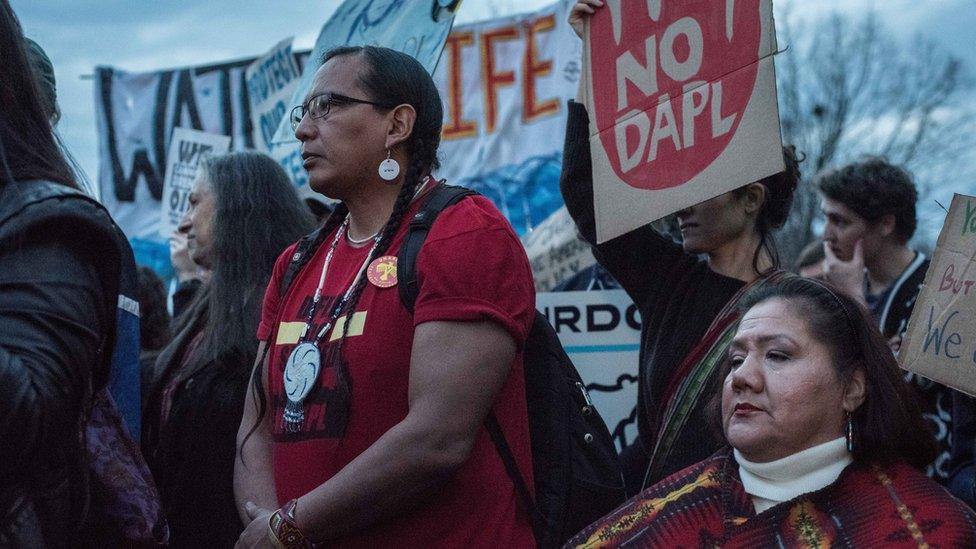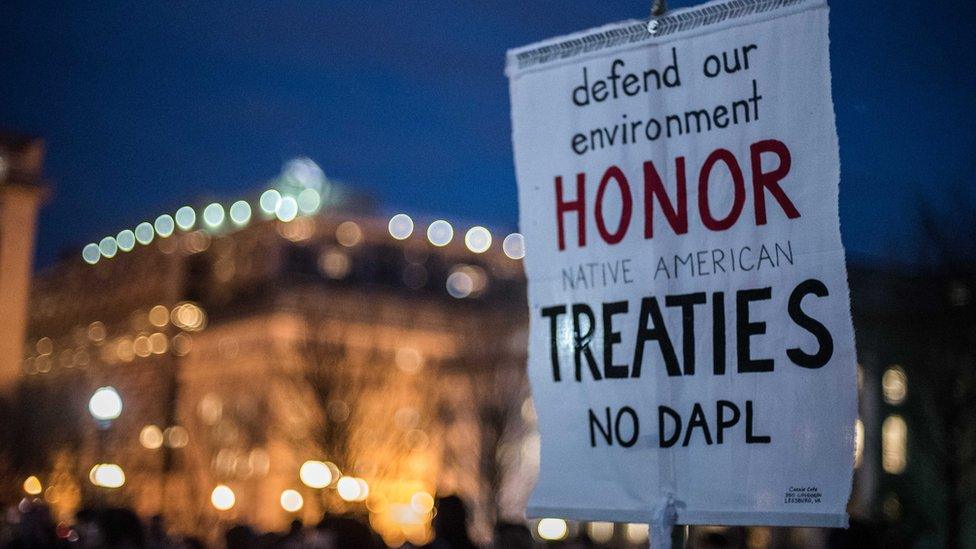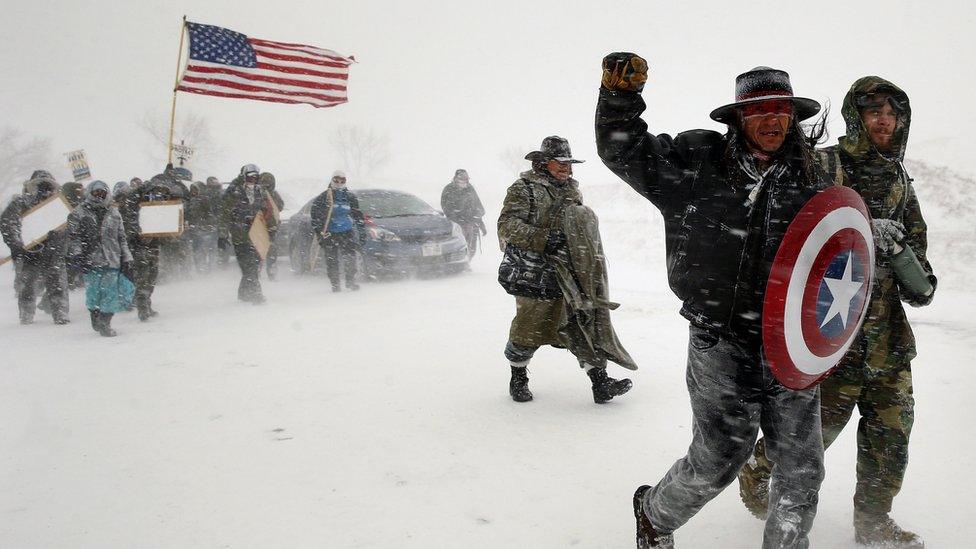Dakota Access pipeline: Is the Standing Rock movement defeated?
- Published

Faith Gemmill, of the Gwich'in Nation, travelled from Alaska to attend the White House protest
Clutching hand-painted signs reading "Water is Life" and "Resist Dakota Access", approximately 500 protesters gathered outside the White House on the evening of 8 February.
They formed a circle and made speeches. A Lakota Sioux man sang prayers, cutting through the winter air in a mournful, high-pitched chant.
The mood was solemn.
Earlier that day, the US Army Corps of Engineers granted the controversial Dakota Access oil pipeline an easement to pass beneath Lake Oahe and the Missouri River, north of the Standing Rock Sioux Reservation.
Since the middle of 2016, thousands of Native Americans have been fighting to prevent the pipeline's completion. In the final days of Barack Obama's presidency the White House put construction on hold pending further assessments, and for a moment the protesters believed they had won. Crowds celebrated with fireworks on the snow-swamped prairie of North Dakota.
But everything changed with the arrival of President Donald Trump.
Within days of taking office, he issued an executive memorandum on 24 January calling for the pipeline to proceed.
Two weeks later, the president's order was obliged, and the Corps granted the easement.
For the Sioux people who opposed this venture and the coalition of 200 tribal nations that joined them, this development is a crushing blow.
"We are a sovereign nation and we will fight to protect our water and sacred places," David Archambault II, the chairman of the Standing Rock Tribe, responded in a statement., external
News spread quickly once the easement was passed, sweeping through Instagram and Facebook under Standing Rock's signature hashtag: #NoDAPL.
For those who have been campaigning for the pipeline, including workers unions, oil and gas advocates and some Republican politicians like Sarah Palin, this was a pivotal victory.

Indigenous activists have planned hundreds of protests across the US to raise awareness of the pipeline
"Our hope is that the new administration in Washington will now provide North Dakota law enforcement the necessary resources to bring closure to the protests," said Kyle Kirchmeier, the sheriff of the local Morton County Police, in a press release.
The last 1.5 mile (2.4 km) stretch of the pipeline is expected to be completed in less than 90 days.
Activist groups have mobilised in an attempt to reverse the decision, planning direct actions in New York, Chicago and hundreds of other locations, external across the US.
These marches will culminate in a large-scale "Native Nations" march in Washington DC on 10 March, led by the leaders of the Standing Rock Tribe and an array of their core advocates, including the influential Indigenous Environmental Network, external.
"Take action, any way you can, now," Erin Wise, a member of the Jicarilla Apache and Laguna Pueblo nations, instructed the crowds outside the White House.
"We have not lost. We are still here," she cried.
Campaigners have already enjoyed some success. Following a "boycott" initiative aimed at depriving the multi-billion dollar oil infrastructure project of funding, two city councils, most notably Seattle, have cut ties with Wells Fargo Bank - a chief lender to Dakota Access LLC - on account of its ties to the pipeline.
The move will deprive the bank of $3bn (£2.4bn) in city funds, a significant financial and public relations blow, which could deter future investment in Dakota Access.
A legal challenge against the pipeline has also been mounted.
A lawsuit , externalhas been ongoing between the Standing Rock and Cheyenne River tribes and the federal government since September 2016.
The plaintiffs filed a request for a temporary halt to pipeline construction in federal court in Washington DC on 9 February.

The Dakota Access pipeline controversy has helped foster an unprecedented alliance of indigenous nations
They argued that the Army Corp of Engineers was wrong to terminate an Environmental Impact Statement they were compiling, which had been initiated by President Obama, but was swiftly shelved once President Trump assumed office.
The tribes may also request a summary judgement on their lawsuit, which would fast-track their case and compel the judge to make a ruling ahead of schedule - either in favour of the tribes or in favour of the government.
"It's a long shot," said Dallas Goldtooth, a Lakota activist and prominent leader of the Standing Rock movement, in a statement, external on Facebook.
"Both scenarios [the temporary injunction and the summary judgement] are extremely risky."
If legal action and protest marches fail, a statement on the Standing Rock Sioux Tribe's website, external says the tribe will seek to "shut the pipeline operations down."
By what means remains unclear.
Although as many as 10,000 people were camped out in North Dakota in solidarity with Standing Rock in December, the Native American camps have shrunk considerably since.
Between 300 and 500 people are currently living near the confluence of the Missouri and Cannonball Rivers in three camps: Oceti Sakowin, Sacred Stone and Rosebud Sicangu.

Residents there - who include representatives of dozens of indigenous nations, environmental activists and military veterans - will be at risk of flooding when the snow melts.
In a slow, bitterly cold process, they are currently relocating their tents, trucks, yurts and teepees to higher ground leased by the Cheyanne River Sioux. The original camps could be vacated within a matter of weeks.
"People are scared," says Linda Black Elk, who runs a permanent medical facility in the area.
"There is a feeling that the police can move in at any moment, and that they can do anything now they have the government on their side."
Theda New Brest, a member of the Blackfoot Confederacy, also believes the Standing Rock tribal alliance faces difficult days ahead.
"We are on the edge of a precipice," she says.
"We have to stand. Mother Earth is life."
Neither the Standing Rock Tribe, nor its allies, intend to stand down in the wake of their latest setback.
- Published9 February 2017

- Published2 September 2016